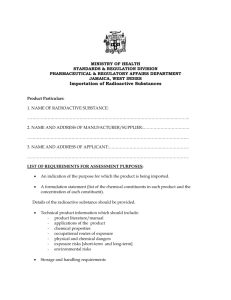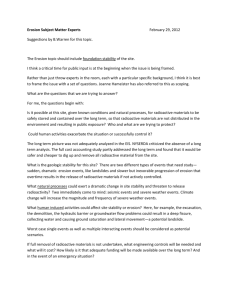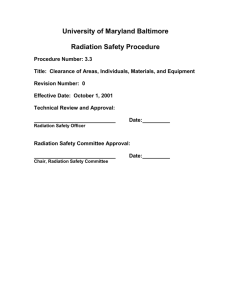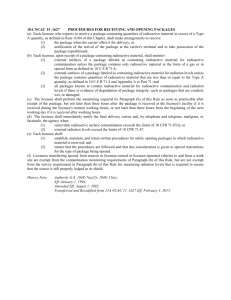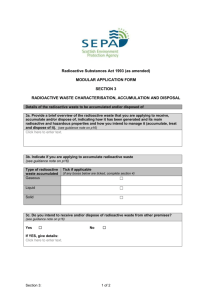Recommendations - University of Reading
advertisement
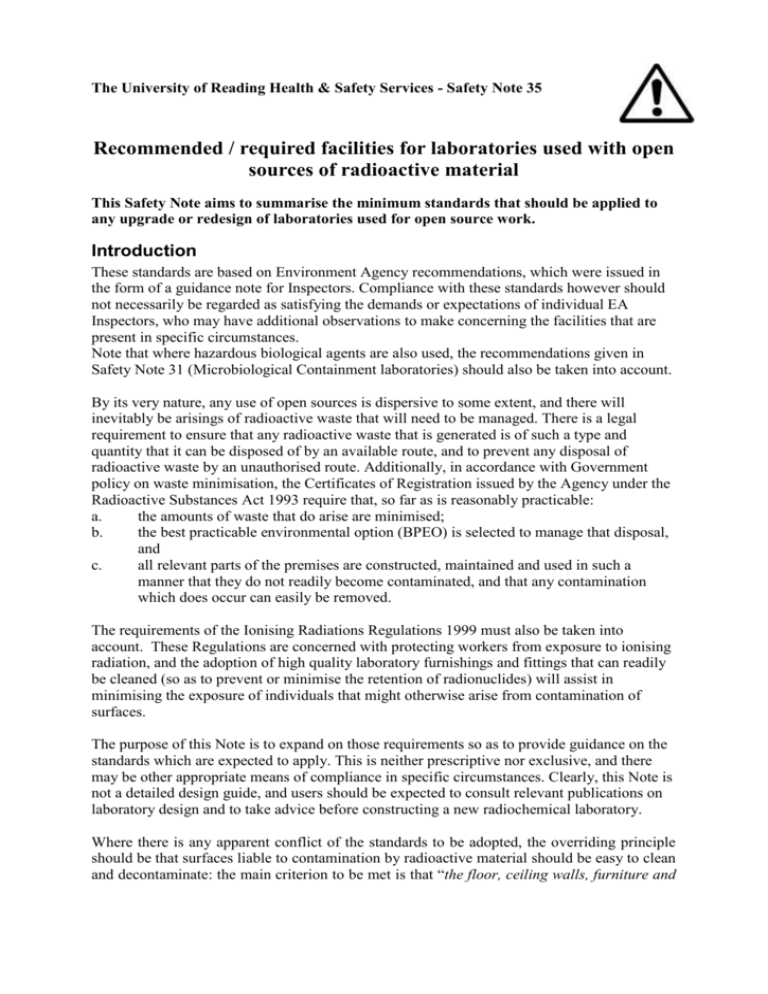
The University of Reading Health & Safety Services - Safety Note 35 Recommended / required facilities for laboratories used with open sources of radioactive material This Safety Note aims to summarise the minimum standards that should be applied to any upgrade or redesign of laboratories used for open source work. Introduction These standards are based on Environment Agency recommendations, which were issued in the form of a guidance note for Inspectors. Compliance with these standards however should not necessarily be regarded as satisfying the demands or expectations of individual EA Inspectors, who may have additional observations to make concerning the facilities that are present in specific circumstances. Note that where hazardous biological agents are also used, the recommendations given in Safety Note 31 (Microbiological Containment laboratories) should also be taken into account. By its very nature, any use of open sources is dispersive to some extent, and there will inevitably be arisings of radioactive waste that will need to be managed. There is a legal requirement to ensure that any radioactive waste that is generated is of such a type and quantity that it can be disposed of by an available route, and to prevent any disposal of radioactive waste by an unauthorised route. Additionally, in accordance with Government policy on waste minimisation, the Certificates of Registration issued by the Agency under the Radioactive Substances Act 1993 require that, so far as is reasonably practicable: a. the amounts of waste that do arise are minimised; b. the best practicable environmental option (BPEO) is selected to manage that disposal, and c. all relevant parts of the premises are constructed, maintained and used in such a manner that they do not readily become contaminated, and that any contamination which does occur can easily be removed. The requirements of the Ionising Radiations Regulations 1999 must also be taken into account. These Regulations are concerned with protecting workers from exposure to ionising radiation, and the adoption of high quality laboratory furnishings and fittings that can readily be cleaned (so as to prevent or minimise the retention of radionuclides) will assist in minimising the exposure of individuals that might otherwise arise from contamination of surfaces. The purpose of this Note is to expand on those requirements so as to provide guidance on the standards which are expected to apply. This is neither prescriptive nor exclusive, and there may be other appropriate means of compliance in specific circumstances. Clearly, this Note is not a detailed design guide, and users should be expected to consult relevant publications on laboratory design and to take advice before constructing a new radiochemical laboratory. Where there is any apparent conflict of the standards to be adopted, the overriding principle should be that surfaces liable to contamination by radioactive material should be easy to clean and decontaminate: the main criterion to be met is that “the floor, ceiling walls, furniture and fittings in any part of the premises where a registered substance is used are maintained in such a condition that they can easily be cleaned.” In common with the recommendations for microbiological laboratories, surfaces should be impervious to water, and resistant to the effects of acids, alkalis, solvents and disinfectants. In some cases, materials may specifically bind certain types of ions, for example, stainless steel tends to bind phosphate ions quite strongly, which may present a problem where 32P is used in significant quantities – so even though the surface may comply with the recommendations for chemical resistance, the chemical nature of the isotopes in use will have to be taken into account. The benchmark for the standards given in this Note is a new radiochemical laboratory. Inspectors are expected to have regard to the criterion of reasonable practicability when assessing the suitability of facilities for specific circumstances. It therefore may not be appropriate to impose these standards where any of the following are involved: existing facilities or holdings only of the less radio-toxic nuclides such as tritium or carbon-14; or minor usage, such as a few radioimmunoassay kits; or “one-off” (as opposed to continuing) uses. In such cases, the facilities be such that use of open sources is restricted to areas that can be readily cleaned up [for example, performing all operations within the confines of a plastic tray lined with absorbent Benchkote paper], and be clearly marked as being used for the use of radioactive materials. Specific guidance has been produced by the National Radiological Protection Board on the categorisation and designation of radiochemical laboratories (Reference 1). It should be noted that the categories and associated facilities are based on occupational radiation exposures, rather than waste minimisation principles, and a proposal involving the facilities indicated by NRPB Categories IV and V may need particular scrutiny from the Agency’s perspective. Nevertheless, they are a useful indication of what may be expected at various levels of work. The Association of the British Pharmaceutical Industry has also published specific guidelines for that industry (Ref. 2) Recommendations 1. Floors 1.1 The floor should be covered with an impervious surface such as a continuous sheet of PVC or linoleum at least 2.5 mm thick. 1.2 Joints between sheets are not recommended, but may be permitted if the joints are welded and regularly inspected to ensure the absence of a seepage path for contamination. Joints ideally should be welded. All edges at the walls should be sealed or welded to prevent seepage of spilled materials. 1.3 The floor covering should be coved to the wall to a height of about 15 cm contiguous with the floor surface, but a coved skirting which seals the gap between the floor and the wall may be acceptable for areas in which only a small amount of open source work is done. 1.4 Any non-slip sealant material used to facilitate cleaning may be applied provided that spilled materials can be easily removed during the decontamination procedure. Generally, epoxy resin coatings are easily decontaminated. 1.5 As an alternative to a sheet material covering (such as PVC), an epoxy resin coating may provide an acceptable finish on smooth concrete. 2. Walls and Ceilings 2.1 The walls and ceilings should generally be smooth and painted with a hard gloss or high quality waterproof emulsion to facilitate cleaning. (BS 4247 Part 2). The use of stippled surfaces or a paint finish applied to unplastered concrete blocks may be undesirable. Painting with vinyl emulsion is not recommended – acrylic emulsion provides a much more durable surface. For higher grade laboratories, an oil-based paint or an impervious two-pack isocyanate resin coating may be required, especially if the laboratory may require fumigation by formaldehyde [for microbiological reasons.] 2.2 A note of caution: many paints undergo chemical or physical reactions with certain radionuclides. A more important criterion may therefore be the ease with which the paint can be stripped off again rather than its cleanability properties. A known problem occurs with chloride ions which may bind irremovably with painted surfaces. 2.3 Suspended ceilings may potentially cause problems due to penetration of contamination. 2.4 Joints should be sealed or filled with silicone type materials to facilitate cleaning (or removal in the event that decontamination cannot be achieved). Service penetrations in walls and ceilings should be sealed and coved. 3. Wash-hand basin and Changing facilities 3.1 Wash hand basins should be of the standard “non-hand-touch” type recommended for microbiological containment laboratories. Elbow- operated taps are acceptable, but for higher grade labs, optical-sensor operation is recommended. Hand-drying facilities should always be provided. The hand wash basin should always be located near the main exit from the laboratory, to act as a prompt for occupants to wash their hands before they leave. 3.2 As a minimum, hanging space for lab-coats should be provided near the laboratory entrance. For higher grade labs, a lobby/ changing area should be provided, so that outdoor clothing is stored separately from lab coats. In some cases, lab coats should be colour coded, to help segregate work done in the open-source lab from that done elsewhere. 4. Doors and Windows 4.1 Wooden surfaces should be covered with plastic laminate material or painted with a good quality polyurethane gloss paint or varnish. See 2.1 and 2.2 above. 4.2 Security of keeping radioactive materials is essential and therefore doors should usually be lockable to ensure safe keeping or to restrict access in the event of major spillage of the materials. Doors leading off public places and which are frequently opened may additionally be secured by use of a key-pad lock. For some Areas, it may be preferable to provide a high level of security for a building, rather than for an individual laboratory within a building. 4.3 Where opening windows are fitted, care should be taken that no persons immediately outside the building could be affected by any release of radioactivity. Open widows should not be used as intentional discharge routes. 5. Benches 5.1 Working surfaces should be smooth, hard and non-absorbent and have necessary heat and chemical resistant properties. All gaps and joints should be sealed with a silicone type material. Depending on the type and quantity or radioactive materials used, account may need to be taken of the problems involved in decontaminating certain materials used for bench surfaces. For example: "Corian" apparently locks onto iodine (e.g. I- 125) in several chemical forms; Melamine fixes sodium ions (e.g.Na-22) under some conditions; stainless steels may bind phosphate (e.g.P-32) or chromium (e.g. Cr51) firmly and may be very difficult to decontaminate. 5.2 The benchtops should be coved (upstand) at the rear against walls. Gaps should be sealed with a silicone type material. Benchtops may also have rounded front edges (lipped) so as to give fewer entry points for contamination - although some users feel this increases the likelihood of spills on to the floor, as the operator may misjudge where the flat surface of the bench finishes. Some bench top designs have a raised front lip which can help prevent a spillage running off the bench on to the floor. 5.3 Exposed wood, including under benches and under bench cupboards, should be painted with a good quality hard gloss paint or polyurethane varnish or laminated. The use of wood surfaces should be avoided on all new laboratory designs. 5.4 Users should carry out regular inspections to ensure that cracked surfaces are repaired or painted as appropriate. 5.5 Dedicated areas of bench should be set aside for radioactive work and be clearly delineated. It is good working practice to work in lined plastic or metal trays on bench tops - and, especially, in dispensing / preparation cabinets where larger quantities of activity are involved - to minimise spills and spread of contamination. Disposable absorbent coverings such as "Benchkote" may similarly be useful - but as a supplement to, rather than instead of, proper bench surfaces: these coverings may therefore best be used inside trays. 6. Waste Disposal Sinks and Drainage Pipes 6.1 Sinks for the disposal of radioactively contaminated aqueous liquid waste should be constructed of suitable material: for most applications, stainless steel is preferred. Where possible, combined sinks and draining boards should be used, with rounded front edges and coved (upstand) at the rear against walls. Ideally an easily decontaminable rear splash plate should extend a reasonable distance up the wall behind the sink. Side splash guards may also be useful. 6.2 As noted in 5.1 above, phosphate ions may bind strongly on to stainless steel, and this may cause problems in laboratories where P-32 is used in quantity. (Similar problems may arise where old fashioned sinks have been sealed with putty or in hard water areas where a calcium phosphate layer may be precipitated in the sink). Borosilicate glass sanitary ware may be appropriate in some circumstances. 6.3 Small diameter U-shaped or bottle traps should be used, instead of large traps or catch pots, so as to avoid accumulations of radioactive sediments. 6.4 The drain should be connected as directly as possible to the main foul water sewer leaving the premises. Holding tanks are generally undesirable in terms of sedimentation, but may be used by some laboratories for other reasons - such as confirming compliance with chemical discharge consent conditions. The discharge route should be mapped and recorded for future reference in case of maintenance on the system. Drainage system materials should take into account the possible build up of contamination on surfaces. NB. All drainpipe materials may retain specific radionuclides. The most generally useful type - "Vulcathene" fixes iodine very strongly - which may be significant where the radioiodines have to be disposed of through drains of this material. 6.5 Drainage pipes for radioactive effluent should be labelled with the ionising radiation symbol up to a point at which their contents are diluted substantially with frequently flowing, non-radioactive effluents. This is to alert maintenance staff and thus prevent unauthorised disposal of any contaminated pipes removed during maintenance work. Pipes should be well-supported along a suspended run, should be down-sloped to prevent accumulations of radioactivity, and, where reasonably practicable, should be made accessible - for example by the use of demountable panels - and subject to periodic inspection so as to assure their integrity. 7. Ventilation and Containment 7.1 Dispensing or preparation of radioactive materials which may cause airborne contamination should be carried out under conditions to prevent dispersal of the substances. In particular, volatile radioactive materials should never be used in the open laboratory, only in appropriate containment such as a fume cupboard. Recirculating ventilation systems may be inappropriate for volatile radioactive materials. 7.2 General dilution ventilation (air circulation) should be provided in all radioactive laboratories. Where small quantities of radioactive materials are used, this may be provided using an extractor fan mounted in a window or a wall. 7.3 Where larger quantities of radioactive materials are used, a guiding principle for effective control of contamination is that air movement should be maintained from less- contaminated areas to more-contaminated areas. This may be achieved for example by extracting from a general laboratory area through a fume cupboard to a discharge stack. 7.4 If a fume cupboard is to be used for open-source work (for example, to allow for discharge of radioactive gaseous waste products), the ductwork from the fume cupboard must be appropriately labelled [“Radioactive”] and the amounts discharged must comply with the University’s Certificate of Authorisation. The discharge must go directly to the open air, and must discharge at a minimum height of 3 metres above the roof line / the position of any air intakes to the building. Scrubber fume cupboards should not be used for radioactive materials, because any entrapped radioactive material will be retained in the scrubber system, and will contaminate the whole of the liquid circulatory system for the cupboard. 7.5 Note that the balancing of an extract ventilation system having a number of ducts, dampers and inlet points, so as to achieve design airflow rates, requires considerable skill and expertise. Alterations to damper settings must not be made by unskilled/ untrained personnel. 7.6 A contained work station (Class I - III microbiological safety cabinet or fume cupboard) should be used for dispensing or manipulation of large quantities of radioactive materials. Adequate ventilation by continuous movement of air into the work station should be checked regularly, preferably by measurement with an anemometer. Airflow criteria for fume cupboards are specified in BS 7258. Internal and external surfaces of workstations should be smooth, hard and non-absorbent and have the necessary heat and chemical resistant properties. 7.7 Note that if a microbiological safety cabinet – or any other form of work station fitted with HEPA filters – is used with radioactive material, the filters are liable to become contaminated with entrapped radioactive dust particles or aerosol particulates. This would be in addition to any microbiological risk involved, and filters may consequently have to be disposed of as radioactive waste after microbiological decontamination. Personnel involved in servicing such cabinets must be warned of the risk(s) of contamination, and informed of the procedures to be followed if radioactive contamination is detected.. 8. Radioactive Storage Facilities (including Waste) 8.1 Adequate storage space should be available to keep essential equipment in order to minimise the cluttering of equipment near working areas, and reduce the risk of spreading contamination. It may be desirable to have an area set aside for the storage of equipment awaiting decontamination. 8.2 All refrigerators / freezers, and radioactive materials within them, should be easily identified (labelled) and should be lockable and should be kept locked unless they are under surveillance, especially in large general laboratories. Refrigerators / freezers should be regularly defrosted. It should be noted that volatile radionuclides, in particular tritium, may accumulate in the ice: it is good practice for the user to check this periodically. 8.3 Waste disposal bins in the laboratory (used for storing solid waste awaiting disposal) should be constructed of a material which is robust, and preferably should be footoperated. The lid should be closed when not in use and the contents in the bag sealed or secured before removing them from the bin. All sharps, bottles, tubes, etc should be placed in sharps containers to ensure safe handling of the, materials. Bins located outside the control of the user must be secure to prevent misuse of the contents. 8.4 Adequate storage space (eg. a marked and delineated shielded area, or separate store room) should be available for radioactive waste either inside or outside the laboratory. The storage space (or the laboratory containing it) must be kept locked when not occupied and may need to be under surveillance. 9. Other Facilities 9.1 Adequate decontamination facilities, including decontamination solutions, should be available. "Decon" (also "Radiacwash", "Countoff” etc.) is principally useful where heavy-metal contamination is present, as its special properties are in solubilising poorly soluble metals. In other circumstances, its performance may be similar to other phosphate free detergents. For most labs only the ordinary detergent used for washing up and liquid soap for hand washing should be needed, although certain other more specialist cleaning agents may be used for special purposes. It is important that some of the old-fashioned laboratory cleaning agents such as chromic acid and permanganic acid are never used in radioactive areas (risks of fire, explosion and volatilisation of radioactive materials). More aggressive decontamination agents should normally be held centrally as they require specialised knowledge to use them properly and safely. 9.2 A contamination monitor should be available and it must be appropriate for the type of radionuclides used in the laboratory. Indirect monitoring (by liquid scintillation counting of swabs taken from surfaces) may be needed for soft beta emitters such as carbon- 14 and (almost always) tritium. Records demonstrating that instruments are checked before use and are calibrated are required. A log book (or equivalent record) should be available to show that the laboratory is regularly monitored (benches, sinks, floors, drainage traps and equipment), that the results are recorded, and that any necessary decontamination is carried out. 9.3 Tacky mats may usefully be installed in laboratory doorways, to prevent the spread of contamination. Monitoring of these mats may give early warning of a contamination problem. 9.4 Warning signs, clearly and legibly marked with the word "Radioactive", with the Ionising Radiation symbol conforming with BS3510: 1968 or ISO 36 1, and any other information necessary (contact person, telephone number, etc), should be placed on doors, cupboards, equipment, refrigerators, working areas, drainage pipes, sinks, storage facilities, sewers, exhausts as appropriate. It would be useful to include an indication of the maximum holdings in the laboratory and the laboratory status [“Supervised Area”, or “Controlled Area”, as applicable] on the sign placed on the door. Warning signs should only be used when there is a real possibility of contamination: in particular, indiscriminate use of "radioactive" warning tape should be avoided. Generally, ancillary items such as pens and books should not be used where there is a possibility of contamination and therefore should not require warning signs. 9.5 Stools and chairs should either be non-upholstered, or be upholstered in a nonabsorbent material covered with an impervious surface that is easy to clean. 9.6 Adequate lighting should be provided throughout the laboratory, particularly to enable operators to see spillage easily. 9.7 Particular considerations apply to users who handle tritium in quantity. Although this is a rather specialised field affecting relatively few users, nevertheless they may find it useful to be aware that tritium may be readily converted to tritiated water, which when allowed into the working environment moves with atmospheric water vapour. It is taken up by most common materials - wood, paper, clothing - and this can make them impossible to decontaminate. It is the usual practice for a facility handling large amounts of tritium (multi-GBq quantities) to be separate from other buildings to prevent the spread of radioactivity beyond the controlled area, and to allow any escape to be diluted by the outside atmosphere. References 1. A P Hudson and J Shaw, 1993. Categorisation and Designation of Working Areas in which unsealed Radioactive Materials are Used. National Radiological Protection Board Memorandum NRPB - M443. 2. Association of the British Pharmaceutical Industry, 1996. Guidelines on the Control of Radioactive Substances in the Pharmaceutical Industry. Published by the ABPI, 12 Whitehall, London SWIA 2DY). Malcolm Iosson Biological & Radiation Safety Officer Health & Safety Services October 2004


